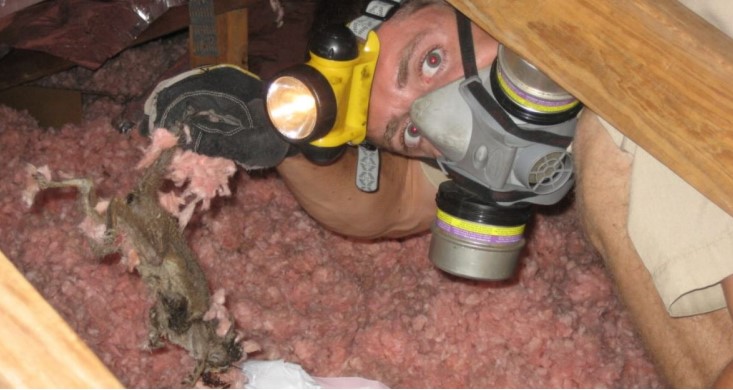Encountering a dead animal smell in or around your property can be unsettling and challenging. Addressing the odor efficiently requires identifying the source and properly removing it, as it can lead to health risks and further issues. Knowing how to tackle this situation will help restore comfort to your environment.
First, check where animals might hide, such as under decks, garages, or walls. Once you locate the source, safely dispose of the animal according to local regulations and wear gloves and a mask to protect yourself from harmful particles. After removal, the odor can linger, so use odor neutralizers like activated charcoal or vinegar to eliminate the smell effectively.
If the smell persists despite your efforts, professional help may be necessary. Experts can assist in removal and sanitation, ensuring your space is free of harmful bacteria. By taking prompt action, you can maintain a healthy and pleasant atmosphere in your home or yard.
Identification and Immediate Actions
Identifying the source of dead animal smell is crucial for effective action. Immediate steps, such as focusing on locating the source, taking precautions, and starting the cleaning process, can help mitigate the odor and ensure safety.
Locating the Source
Begin by identifying where the smell is strongest. Common areas include:
Attics: Animals often enter through vents or gaps.
Crawl spaces: Check under your home where animals may hide.
Walls: Sounds of movement can indicate animals trapped within.
Use your nose to trace the smell and your ears to listen for any noises. If you can’t reach the source safely, consider seeking professional help. It’s critical to pinpoint the exact location to plan the next steps effectively.
Safety Precautions
Take necessary safety measures to protect yourself during this process. Equip yourself with:
Gloves: Use disposable gloves to avoid direct contact with any remains.
Masks: A mask prevents inhalation of harmful bacteria and odor.
Protective eyewear: Shield your eyes from debris.
Ensure adequate ventilation in the area. Open windows and doors to allow fresh air in. Avoid touching any substances directly and always wash your hands thoroughly after handling contaminated items. If the smell is too overwhelming, consider leaving the area until it’s manageable.
Initial Cleaning Steps
Once you locate the source and ensure safety, initiate the cleanup. Follow these steps for effective removal:
Remove the animal: If it’s safe, dispose of it following local regulations. If unsure, call animal control.
Seal the area: Use plastic bags to contain the remains.
Clean the site: Use disinfectant to wipe surfaces.
After disposal, scrub the area with an enzyme-based cleaner to neutralize odor-causing bacteria. Verify if you need to contact a professional for odor removal or deeper cleaning. Consistently monitor the area for any lingering smells or signs of animals returning.
Read also: Support Animal Rights with Exotic Animal Shelter in Lincoln, NE
Professional Removal and Odor Elimination

Addressing the challenge of dead animal odors requires a structured approach. Utilizing professional services can ensure safe removal and effective odor elimination.
Choosing a Professional Service
When selecting a service for dead animal removal in Dallas, it’s vital to consider their expertise and reputation. Look for companies specializing in dead wildlife removal and have experience with various animals, including rodents. Check for licensing and insurance, as these assure quality work.
Customer reviews and testimonials can help gauge the effectiveness of the service. Services like emergency dead animal removal in Dallas often have quicker response times, which is crucial for minimizing odor issues. Compare at least three providers and inquire about their methods and pricing to ensure you choose the best fit for your needs.
Understanding Removal Processes
Professional dead animal removal typically involves several key steps. Initially, the service will conduct a thorough inspection of your property to locate the source of the odor. Once the animal is located, they will use humane methods to remove it safely, ensuring minimal environmental disruption.
After removal, technicians will assess potential entry points to prevent future issues. They may use specialized equipment for dead rodent removal in Dallas to ensure complete extraction. Understanding these processes can enhance your confidence in hiring a professional, ensuring you receive comprehensive service.
Post-Removal Sanitization
Post-removal, it’s crucial to address the lingering odor and potential contaminants. Professionals often use advanced cleaning solutions and techniques to sanitize the area where the animal was found. This may involve disinfecting surfaces and using deodorizing agents to neutralize any smell.
For serious odor issues, services focusing on odor removal in Dallas may utilize ozone treatments or thermal fogging. These methods effectively eliminate remnants of the smell, leaving your environment clean and fresh.
If you’re facing wildlife or pest removal issues, consider contacting Critter Stop at (214) 234-2616 for a free inspection. With a reputation for high-quality work and excellent customer service, they can address your concerns swiftly and effectively.



